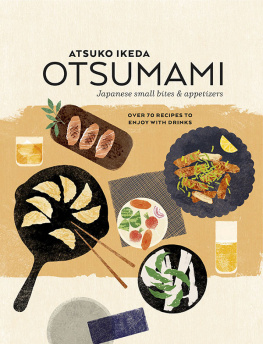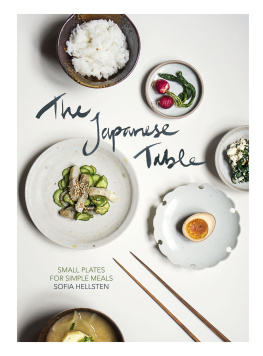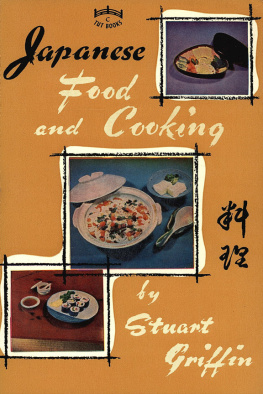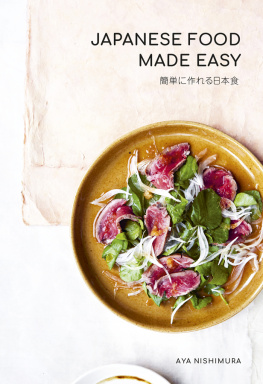



 contents
contents
 Walk beneath the paper lantern, pull back the half curtain and enter a world that suddenly feels like the real Japan. Waiters boisterously welcome you through the door and call out orders to the kitchen. People sit on tatami mats sipping glasses of beer or small cups of sake, chatting about work, family, life. Its relaxed, welcoming and not bound by dizzying rules of etiquette. This is the traditional izakaya the Japanese tavern, where the alcohol flows but simple and delicious food is every bit as important. The food comes in small serves designed to nibble on and share.
Walk beneath the paper lantern, pull back the half curtain and enter a world that suddenly feels like the real Japan. Waiters boisterously welcome you through the door and call out orders to the kitchen. People sit on tatami mats sipping glasses of beer or small cups of sake, chatting about work, family, life. Its relaxed, welcoming and not bound by dizzying rules of etiquette. This is the traditional izakaya the Japanese tavern, where the alcohol flows but simple and delicious food is every bit as important. The food comes in small serves designed to nibble on and share.
Created from the words i (to sit or remain) and sakaya (sake shop), izakayas originated as simple liquor stores that began to serve food to busy working men in the developing city of Edo, now Tokyo. In the last few decades, the izakaya has received a good dusting off, and while you can still find traditional izakayas not much bigger than a shoebox with a bar and wooden shelving to the ceiling, there are now many slick modern establishments and popular izakaya chains. Classic izakaya dishes include sashimi, edamame (salted fresh soy beans), yakitori (grilled skewers) and agedashi tofu a dish of deep-fried silken tofu served in a dashibased broth. Some izakayas specialise in one particular dish, such as tempura or grilled fish, and the specials board is always a guide to the best morsels on offer. Many izakaya menus feature relaxed Japanese interpretations of Western dishes, such as korokke (croquettes) or potato salad in mayonnaise. Ingredients like cheese, butter and bacon sit comfortably alongside miso, soba noodles and nori as the foods that Japanese people love.
This hybrid cuisine is so established in Japan that it has its own name yoshoku including anything from spaghetti to hambagu (yes, hamburger!). Like Japanese food in general, this collection of classic izakaya recipes is guided by the principles of direct flavours, quality ingredients and pleasing presentation. You wont need oodles of ingredients to cook these dishes, or a whole kitchen full of equipment and utensils. Just get out your wok, dust off your barbecue hotplate, arm yourself with some miso and sake, and discover the exciting world of izakaya-style cooking.  lotus chips oil, for frying 200 g (7 oz) lotus root, peeled and thinly sliced salt, to serve ichimi powder, to serve Pour enough oil into a wok or deep frying pan to come one-third of the way up the side and place over high heat until shimmering. Cook the lotus root, in batches, for 35 minutes, or until golden.
lotus chips oil, for frying 200 g (7 oz) lotus root, peeled and thinly sliced salt, to serve ichimi powder, to serve Pour enough oil into a wok or deep frying pan to come one-third of the way up the side and place over high heat until shimmering. Cook the lotus root, in batches, for 35 minutes, or until golden.
Drain on paper towel and sprinkle with the salt and ichimi powder to serve. Serves 4 
 japanese pickles 2 tablespoons Japanese rice vinegar 1 tablespoon caster (superfine) sugar 1 teaspoon Japanese soy sauce 1 teaspoon finely chopped ginger Lebanese (short) cucumber, sliced lengthways into cm ( in) thick strips and seeded 3 baby carrots, mixed colours, sliced into cm in) rounds Combine the vinegar, sugar, soy sauce and ginger in a small bowl and stir to dissolve the sugar. Put the cucumber and carrot in a serving bowl. Pour over the vinegar mixture and cover with plastic wrap. Place in the fridge for 4 hours, stirring occasionally, to allow the flavours to develop. If desired, drain off extra liquid before serving.
japanese pickles 2 tablespoons Japanese rice vinegar 1 tablespoon caster (superfine) sugar 1 teaspoon Japanese soy sauce 1 teaspoon finely chopped ginger Lebanese (short) cucumber, sliced lengthways into cm ( in) thick strips and seeded 3 baby carrots, mixed colours, sliced into cm in) rounds Combine the vinegar, sugar, soy sauce and ginger in a small bowl and stir to dissolve the sugar. Put the cucumber and carrot in a serving bowl. Pour over the vinegar mixture and cover with plastic wrap. Place in the fridge for 4 hours, stirring occasionally, to allow the flavours to develop. If desired, drain off extra liquid before serving.
Serves 4 oysters with japanese dressing dressing 2 teaspoons Japanese soy sauce 1 teaspoon mirin 2 teaspoons Japanese rice vinegar teaspoon caster (superfine) sugar 2 teaspoons dried shredded wakame 12 oysters, on the shell 50 g (1 oz) salmon roe To make the dressing, combine all the ingredients in a small bowl. Soak the wakame in a bowl of cold water for 5 minutes, or until soft. Drain well. Arrange the oysters on a serving plate and spoon some roe onto each oyster. Spoon over the dressing and some wakame to serve. Serves 4 
 spinach with sesame 2 tablespoons toasted sesame seeds 2 tablespoons dashi stock 1 tablespoon Japanese soy sauce 1 teaspoon caster (superfine) sugar 1 teaspoon mirin 1 bunch English spinach, ends trimmed Place the sesame seeds in a suribachi or mortar and pound until the seeds start to break up.
spinach with sesame 2 tablespoons toasted sesame seeds 2 tablespoons dashi stock 1 tablespoon Japanese soy sauce 1 teaspoon caster (superfine) sugar 1 teaspoon mirin 1 bunch English spinach, ends trimmed Place the sesame seeds in a suribachi or mortar and pound until the seeds start to break up.
Gradually add the dashi stock, pounding as you go, until the mixture is smooth. Stir in the soy sauce, sugar and mirin. Bring a large saucepan of salted water to the boil. Add the spinach and cook for 3 minutes, or until wilted. Drain and plunge into iced water. Drain again, then squeeze to remove any excess water.
Place the spinach on a sushi mat and roll tightly. Cut into even pieces and drizzle with the sesame sauce to serve. Serves 2 crumbed prawns 12 raw prawns (shrimp), peeled, deveined and tails intact 35 g (1 oz cup) plain (all-purpose) flour 2 eggs, lightly beaten 60 g (2 oz/1 cup) panko (Japanese breadcrumbs) oil, for frying , to serve Use a sharp knife to make three incisions on the underside of the prawns. Put the flour, egg and panko in separate bowls. Dust the prawns in the flour, dip in the egg, then coat with the panko. Pour enough oil into a wok or deep frying pan to come 5 cm (2 in) up the side and place over high heat until shimmering.
Add the prawns and cook for 1 minutes on each side, or until cooked through. Drain on paper towel and serve with the ponzu sauce. Serves 4 
 green beans with miso miso sauce 3 tablespoons white miso 1 teaspoon caster (superfine) sugar 2 tablespoons sake teaspoon Japanese soy sauce 5 drops of sesame oil 150 g (5 oz) baby green beans, trimmed To make the miso sauce, combine all the ingredients in a small bowl along with 2 tablespoons of water. Bring a large saucepan of salted water to the boil. Add the beans and cook for 2 minutes, or until just tender. Drain and plunge into a bowl of iced water.
green beans with miso miso sauce 3 tablespoons white miso 1 teaspoon caster (superfine) sugar 2 tablespoons sake teaspoon Japanese soy sauce 5 drops of sesame oil 150 g (5 oz) baby green beans, trimmed To make the miso sauce, combine all the ingredients in a small bowl along with 2 tablespoons of water. Bring a large saucepan of salted water to the boil. Add the beans and cook for 2 minutes, or until just tender. Drain and plunge into a bowl of iced water.
Drain again. Transfer the beans to a bowl. Add the miso sauce, toss to combine and serve. Serves 4 fried pork stuffed with cheese 2 x 100 g (3 oz) pork loin fillets 40 g (1 oz) gruyere cheese 2 tablespoons plain (all-purpose) flour 1 egg, lightly beaten 30 g (1 oz/ cup) panko (Japanese breadcrumbs) 2 tablespoons oil cabbage leaves, cut into squares, to serve tonkatsu sauce, optional, to serve Slice each pork fillet in half horizontally, without cutting all the way through. Open out and use a meat mallet to flatten out slightly. Slice the gruyere in half and place a piece on one side of each pork fillet.
Next page


















 contents
contents
 Walk beneath the paper lantern, pull back the half curtain and enter a world that suddenly feels like the real Japan. Waiters boisterously welcome you through the door and call out orders to the kitchen. People sit on tatami mats sipping glasses of beer or small cups of sake, chatting about work, family, life. Its relaxed, welcoming and not bound by dizzying rules of etiquette. This is the traditional izakaya the Japanese tavern, where the alcohol flows but simple and delicious food is every bit as important. The food comes in small serves designed to nibble on and share.
Walk beneath the paper lantern, pull back the half curtain and enter a world that suddenly feels like the real Japan. Waiters boisterously welcome you through the door and call out orders to the kitchen. People sit on tatami mats sipping glasses of beer or small cups of sake, chatting about work, family, life. Its relaxed, welcoming and not bound by dizzying rules of etiquette. This is the traditional izakaya the Japanese tavern, where the alcohol flows but simple and delicious food is every bit as important. The food comes in small serves designed to nibble on and share. lotus chips oil, for frying 200 g (7 oz) lotus root, peeled and thinly sliced salt, to serve ichimi powder, to serve Pour enough oil into a wok or deep frying pan to come one-third of the way up the side and place over high heat until shimmering. Cook the lotus root, in batches, for 35 minutes, or until golden.
lotus chips oil, for frying 200 g (7 oz) lotus root, peeled and thinly sliced salt, to serve ichimi powder, to serve Pour enough oil into a wok or deep frying pan to come one-third of the way up the side and place over high heat until shimmering. Cook the lotus root, in batches, for 35 minutes, or until golden.
 japanese pickles 2 tablespoons Japanese rice vinegar 1 tablespoon caster (superfine) sugar 1 teaspoon Japanese soy sauce 1 teaspoon finely chopped ginger Lebanese (short) cucumber, sliced lengthways into cm ( in) thick strips and seeded 3 baby carrots, mixed colours, sliced into cm in) rounds Combine the vinegar, sugar, soy sauce and ginger in a small bowl and stir to dissolve the sugar. Put the cucumber and carrot in a serving bowl. Pour over the vinegar mixture and cover with plastic wrap. Place in the fridge for 4 hours, stirring occasionally, to allow the flavours to develop. If desired, drain off extra liquid before serving.
japanese pickles 2 tablespoons Japanese rice vinegar 1 tablespoon caster (superfine) sugar 1 teaspoon Japanese soy sauce 1 teaspoon finely chopped ginger Lebanese (short) cucumber, sliced lengthways into cm ( in) thick strips and seeded 3 baby carrots, mixed colours, sliced into cm in) rounds Combine the vinegar, sugar, soy sauce and ginger in a small bowl and stir to dissolve the sugar. Put the cucumber and carrot in a serving bowl. Pour over the vinegar mixture and cover with plastic wrap. Place in the fridge for 4 hours, stirring occasionally, to allow the flavours to develop. If desired, drain off extra liquid before serving.
 spinach with sesame 2 tablespoons toasted sesame seeds 2 tablespoons dashi stock 1 tablespoon Japanese soy sauce 1 teaspoon caster (superfine) sugar 1 teaspoon mirin 1 bunch English spinach, ends trimmed Place the sesame seeds in a suribachi or mortar and pound until the seeds start to break up.
spinach with sesame 2 tablespoons toasted sesame seeds 2 tablespoons dashi stock 1 tablespoon Japanese soy sauce 1 teaspoon caster (superfine) sugar 1 teaspoon mirin 1 bunch English spinach, ends trimmed Place the sesame seeds in a suribachi or mortar and pound until the seeds start to break up.
 green beans with miso miso sauce 3 tablespoons white miso 1 teaspoon caster (superfine) sugar 2 tablespoons sake teaspoon Japanese soy sauce 5 drops of sesame oil 150 g (5 oz) baby green beans, trimmed To make the miso sauce, combine all the ingredients in a small bowl along with 2 tablespoons of water. Bring a large saucepan of salted water to the boil. Add the beans and cook for 2 minutes, or until just tender. Drain and plunge into a bowl of iced water.
green beans with miso miso sauce 3 tablespoons white miso 1 teaspoon caster (superfine) sugar 2 tablespoons sake teaspoon Japanese soy sauce 5 drops of sesame oil 150 g (5 oz) baby green beans, trimmed To make the miso sauce, combine all the ingredients in a small bowl along with 2 tablespoons of water. Bring a large saucepan of salted water to the boil. Add the beans and cook for 2 minutes, or until just tender. Drain and plunge into a bowl of iced water.